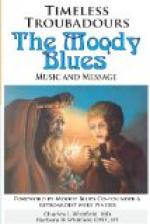A further question arises: how far do the tunes correspond with the structure of the stanza as given by Dante? In some cases both tune and stanza correspond in symmetrical form; but in others we find stanzas [29] which may be divided according to rule conjoined with tunes which present no melodic repetition of any kind; similarly, tunes which may be divided into pedes and coda are written upon stanzas which have no relation to that form. On the whole, it seems that the number of tunes known to us are too few, in comparison with the large body of lyric poetry existing, to permit any generalisation upon the question. The singer accompanied himself upon a stringed instrument (viula) or was accompanied by other performers; various forms of wind instruments were also in use. Apparently the accompaniment was in unison with the singer; part writing or contrapuntal music was unknown at the troubadour period.
As has been said, the stanza (cobla) might vary in length. No poetical literature has made more use of rime than Provencal lyric poetry. There were three typical methods of rime disposition: firstly, the rimes might all find their answer within the stanza, which was thus a self-contained whole; secondly, the rimes might find their answer within the stanza and be again repeated in the same order in all following stanzas; and thirdly, the rimes might find no answer within the stanza, but be repeated in following stanzas. In this case the rimes were known as dissolutas, and the stanza as a cobla estrampa. This last arrangement tended to make the poem a more organic whole than was possible in the first two cases; in these, stanzas might be omitted without necessarily impairing the general effect, but, when coblas estrampas were employed, the ear of the auditor, attentive for the [30] answering rimes, would not be satisfied before the conclusion of the second stanza. A further step towards the provision of closer unity between the separate stanzas was the chanso redonda, which was composed of coblas estrampas, the rime order of the second stanza being an inversion of the rime order of the first; the tendency reaches its highest point in the sestina, which retained the characteristic of the chanso redonda, namely, that the last rime of one stanza should correspond with the first rime of the following stanza, but with the additional improvement that every rime started a stanza in turn, whereas, in the chanso redonda the same rime continually recurred at the beginning of every other stanza.




